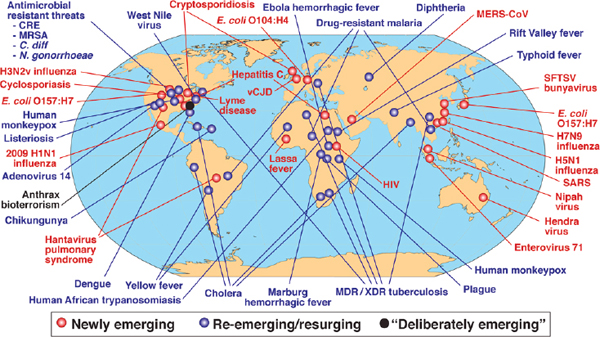Emerging and re-emerging diseases that are appearing now or have appeared in the past in certain regions or throughout the world, pose a high risk or infection to the population.[1]The population that is effected can be infected in many different ways to include zoonotically. The four ways that zoonotic diseases work are through direct contact, indirect contact, vector-borne, and food-borne.[2]The significance of zoonotic diseases is so grand because so much of what we (the modern day person) eat is meat from animals and if the animals that we are eating are infected by infectious diseases then the population of the world is at risk. An example of a zoonotic disease is when Psittacosis was spread throughout Virginia and Georgia because of two poultry slaughter houses that were reported to have been exposed in October 2018[3]. Another example of a zoonotic disease is Nipah the RNA henipavirus that ran rampant in Malaysia and Bangladesh. Nipah is spread through contaminated food then through human to human contact. Nipah is an extremely fatal with a fatality rate up to 75% in certain areas.
Infectious diseases, especially when considered a major outbreak can cause a lot of distress to society and culture. To society major outbreaks will cause families to go without support or entire communities to be demolished. As seen in the DRC societies focus was made to be on the outbreak rather than making sure the country was running properly. Major outbreaks can cause monetary troubles as well as infrastructure troubles when hospitals fill up. On the other hand the culture side of outbreaks can also be a dilemma. When a culture does not vaccinate or provide protective measures against these diseases then very little can be done to stop the outbreak. In some parts of the world drinking and eating different types of wild game is a delicacy, but it is also a major source of disease outbreak. As an example the Nipah virus was thought to have spread because in Bangladesh they drink a tree sap and so does the fruit bat. So video was set up and the fruit bat was caught urinating in the sap and that was the birth of the Nipah virus.[4]
As we as humans look to the future of epidemics or even a pandemic I believe that we are much more prepared to handle the task at hand. The creation of the CDC and the WHO as well as many other national organizations have increase the reaction to certain diseases. Another innovation that I believe has helped is the advance in scientific technology. Compared to 1918 when 50 million people were killed by influenza, I believe that we are much more prepared to research the disease and have the ability worldwide to provide treatment or vaccinations to prevent the spreading. Infectious disease will always have the ability to kill humans and animals, but I believe that with the technology that we have today, that the world can find a solution to any problematic disease.[5]
[1]https://www.bcm.edu/departments/molecular-virology-and-microbiology/emerging-infections-and-biodefense/emerging-infectious-diseases
[2]https://www.cdc.gov/onehealth/basics/zoonotic-diseases.html
[3]https://www.cdc.gov/pneumonia/atypical/psittacosis/surveillance-reporting/outbreaks/2018-poultry-multistate-investigation.html
[4]https://www.who.int/news-room/fact-sheets/detail/nipah-virus
[5]https://www.cdc.gov/flu/pandemic-resources/1918-commemoration/are-we-prepared.htm